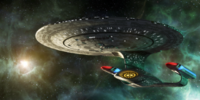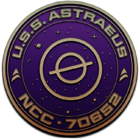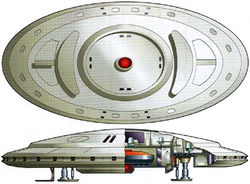Astraeus Auxiliary Craft: Difference between revisions
Jump to navigation
Jump to search
mNo edit summary |
|||
| Line 117: | Line 117: | ||
*'''Armament:''' Two type-9 phaser emitters; 2 torpedo launchers | *'''Armament:''' Two type-9 phaser emitters; 2 torpedo launchers | ||
:The ''Astraeus'' | :The ''Astraeus'' carries two autonomous runabouts for long-range missions. They are fully warp-capable and armed well for small craft and may be deployed to investigate when the ''Astraeus'' is needed elsewhere. | ||
==Captain’s Yacht== | ==Captain’s Yacht== | ||
Revision as of 00:25, 16 September 2022
| USS Astraeus | |||||||||||||
|---|---|---|---|---|---|---|---|---|---|---|---|---|---|
 ACTIVE STATUS | |||||||||||||
| |||||||||||||
Type 8 Medium Short-Range Shuttlecraft
These craft first came into use in 2371 for use with the Intrepid-class during short-term missions. The Alliance was a vessel originally from the Montreal, lined with a special reskarii-based alloy that would protect against tachyon radiation.
- Complement: 1
Classification Shuttlecraft Length 6 meters Mass 3.47 metric tons Capacity 2 crew (6 passengers total) Speed Warp 4 Armaments Type-IV phaser emitters Defenses Deflector shields Hull Composition Duranium, magnesite, carbon Special Features Reskarii alloy lining Individual Vessels Alliance
Type-9 Personnel Shuttlecraft
- Complement: 5
- Currently Active
- Aepinus
- Bassi
- Mendenhall
- Sakharov
- Schawlow
- Type: Medium long-range warp shuttle.
- Accommodation: Two flight crew, two passengers.
- Power Plant: One 400-cochrane warp engine, two 800-millicochrane impulse engines, four RCS thrusters.
- Dimensions: Length, 8.5 m; beam, 4.61 m; height 2.67 m.
- Mass: 2.61 metric tonnes.
- Performance: Warp 6.
- Armament: Two Type-VI phaser emitters.
- The Type-9 Personnel Shuttle is a long-range craft capable of traveling at high warp for extended periods of time due to new advances in variable geometry warp physics. Making its debut just before the launch of the Intrepid-class, this shuttle type is ideal for scouting and recon missions, but is well suited to perform many multi-mission tasks. Equipped with powerful Type-VI phaser emitters, the shuttle is designed to hold its own ground for a longer period of time. Comfortable seating for four and moderate cargo space is still achieved without sacrificing speed and maneuverability. As is standard by the 2360’s, the shuttle is equipped with a medium-range transporter and is capable of traveling through a planet’s atmosphere. With its ability to travel at high-warp speeds, the Type-9 has been equipped with a more pronounced deflector dish that houses a compact long-range sensor that further helps it in its role as a scout. The Type-9 is now being deployed throughout the fleet and is especially aiding deep-space exploratory ships with its impressive abilities.
Type-11 Personnel Shuttlecraft
- Complement: 5
- Currently Active
- Gibbs
- Galliard
- Voigt
- Watson
- Zeleny
- Type: Heavy long-range warp shuttle.
- Accommodation: Four flight crew, six passengers.
- Power Plant: One 400-cochrane warp engine, two 800-millicochrane impulse engines, four RCS thrusters.
- Dimensions: Length, 16 m; beam, 9.78 m; height 4.25 m.
- Mass: 28.11 metric tones.
- Performance: Warp 6.
- Armament: Four Type-V phaser emitters, two micro-torpedo launchers (fore and aft), aft-mounted veritable purpose emitter.
- With an ultimate goal towards creating a useful all-purpose shuttlecraft, the designers of the Type-11 Personnel Shuttle set out to create a craft that was equipped with all the systems of a starship within the shell of a relatively small shuttle. Allocation of the larger Danube-class runabout to starships in the field proved too costly, and with the expressed need by the Sovereign-class development team for a capable shuttle, the Type-11 was born. Its overall frame and components are a meshing of lessons learned in both the Type-9 and Danube-class vessels. Impressive shielding, several phaser emitters, micro-torpedo launchers and a capable warp propulsion system makes this shuttle capable of performing a multitude of tasks. Both the ventral and dorsal areas of the shuttle feature a new magnaclamp docking port that is capable of linking up to other ships similarly equipped. A two-person transporter and a large aft compartment with a replicator adds to the shuttle’s versatility. The end hope is that these all-purpose shuttles will replace the more specific-purpose crafts already stationed on starships, reducing the amount of space needed for shuttle storage in already-cramped bays. The Type-11 is now seeing selective deployment outside the Sovereign-class to further assess its capabilities in the field.
Sphinx Workpods
- Complement: 10
- Type: Light industrial maintenance vehicle
- Accommodation: Two flight crew
- Power Plant: Two RCS thrusters
- Dimensions: Length 6.2 m; beam, 2.6 m; height 2.5 m.
- Performance: Thrusters only
- Armament: Unarmed
- A light maintenance vehicle with room for two. The Sphinx workpod is used primarily for extraship repairs and is a common sight in any large shipbuilding facility. Sphinxes are never intended to stray far from their parent ship or facility. They are more varied and versatile than Workbees, but can be more difficult to maneuver for close work.
Workbees
- Complement: 20
- Type: Light industrial maintenance vehicle
- Accommodation: One pilot/operator
- Power Plant: Two RCS thrusters
- Dimensions: Length 4.5 m; beam, 2.2 m; height 2.4 m.
- Performance: Thrusters only
- Armament: Unarmed
- The workbees have a longer operational time (80 hours) than their Sphinx counterparts, though you wouldn’t want to be stuck in one for that full time. They are essentially hybrids between EVA suits and shuttlecraft: Built for one, but with the tools of a maintenance vehicle for ship repairs. A pair of robotic manipulator arms is folded beneath the main housing, and allows for work to be done through pilot-operated controls. Each Workbee is capable of handling a cargo attachment that makes it ideal for transferring cargo around large starbases and spaceborne construction facilities.
Arrow-Class Runabouts
- Compliment: 2
- Type: Runabout
- Production Base: ASDB Integration Facility, Antares Fleet Yards, Antares IV
- Accommodation: Up to 40 passengers
- Dimensions:
- Length: 26 meters
- Beam: 16.1 meters
- Height: 5.4 meters
- Mass: 160 metric tons
- Performance: Warp 5
- Armament: Two type-9 phaser emitters; 2 torpedo launchers
- The Astraeus carries two autonomous runabouts for long-range missions. They are fully warp-capable and armed well for small craft and may be deployed to investigate when the Astraeus is needed elsewhere.
Captain’s Yacht
- Complement: 1
- Active
- Type: Galaxy-class integrated diplomatic/exploration craft
- Accommodation: Up to 7 officers, 3 flight crew, 4 passengers
- Power Plant: One 400-cochrane warp engine, two 800-millicochrane impulse engines, four RCS thrusters.
- Dimensions: Length, 18 m; beam, 10 m; height 8 m; 2 decks
- Performance:
- Normal Cruise: Warp 4
- Maximum Cruise: Warp 5
- Maximum Rated: Warp 6 for 3 hours
- Armament: Two type-V phaser arrays; auto-modulating shield systems
- Deck Layout:
- Deck 1:
- Cockpit, staterooms (2), flight crew bunks, galley
- Deck 2:
- Propulsion systems, deployable warp nacelles (2), landing gears (2), aerodyne flight motors for atmospheric flight, maintenance access













